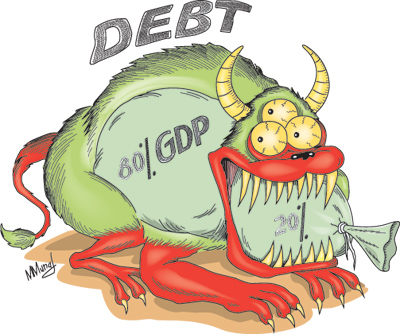Columns
Economists: Mounting debt could constrain growth
View(s):The rising debt burden would be a serious constraint to sustained economic growth. The government should therefore be more prudent in borrowing foreign funds; they should be on more favourable terms and should be put to productive use to generate tradable goods and services.

These conclusions of the technical sessions of the Sri Lanka Economic Association (SLEA) on October 26 brought out the concern of economists that the mounting debt would hamper sustained economic growth. The government target of bringing down the debt to GDP ratio to 60 per cent from nearly 80 per cent last year, if achieved, would have a positive impact on sustaining growth.
Several papers applied up to date econometric and statistical techniques to illustrate the risks of high public debt. Dr. N.S. Cooray of the UN University in Tokyo, in the paper, “Public Debt and Economic Growth in Sri Lanka: Is there any Threshold Level for Public Debt”, co-authored with Hemantha Kumara, expressed growing concerns about the growth implications of public debt with Sri Lanka’s debt stock rising to Rs. 3 trillion or 79.14 per cent of GDP in 2012. While debt enhances growth by investment, it also involves cost by way of interest payments that absorbed 46.12 per cent of government revenue last year. Therefore debt had both positive and negative impacts on growth.
Threshold level of debt
The threshold level over which public debt should not exceed was estimated to be 59.2 per cent of GDP: a figure similar to the government’s target of 60 per cent of GDP that is considered the sustainable level of debt, compared to 79 per cent last year.
Professor Anoma Abeyratne and Ashani Bandaranayake’s study “Impact of indebtedness on economic growth in Sri Lanka” used several statistical techniques to determine the impact of debt on growth. Their overall conclusion in the model they used was that debt had a negative impact on growth, though not a significant one statistically. The Debt Service Ratio they found had a negative effect, though not statistically significant. They found that the impact of external debt on economic growth was negative and statistically significant and the impact of investment-GDP ratio is positive and statistically significant.
The implications of these studies is that the country’s debt could have positive short term gains, while the impact in the longer term may be disadvantageous.
Discussion on debt
The discussion that followed pointed out that the public debt figure was underestimated as several liabilities of the Government were not captured in the official figure. Domestic debt, underestimated as liabilities of the Government, state owned enterprises and other government agencies, were not included in the official domestic debt figure. The Government has relied increasingly on banks lending to loss-making government enterprises and incurred heavy contingent liabilities. These were ultimately government liabilities and therefore part of the public debt. It was not clear whether some foreign borrowing, especially the Chinese loans on commercial terms, were included in the foreign debt figures. If they are not included, their inclusion would increase the foreign debt and the debt to GDP ratio would be much higher than 79 per cent.
Hemaka Amarasuriya, a leading industrialist and Chairman of the National Development Bank, observed that the manner in which the borrowed funds are utilised had an important bearing on the economy. It was not the debt per se but how borrowed funds are used that mattered.

If foreign loans are used for unproductive purposes they would be a heavy burden on the economy and would hamper growth. Many discussants were of the view that much of the high cost foreign borrowing was being utilised for unproductive and wasteful purposes that increases the country’s debt burden, as there is no additional output to service the debt.
While foreign funds could play a vital role in bridging the savings-investment gap, the quantum of borrowing, the conditions of borrowing and the utilisation of funds mattered in determining whether the country’s debt is a positive or negative factor in sustaining economic growth.
Increasing non-concessional loans
A significant feature was the increasingly higher component of foreign debt from non-concessional funding unlike in the past. For the first time, Sri Lanka’s commercial borrowing has exceeded concessional debt this year. This increases foreign debt servicing costs and absorbs a high amount of export earnings.
These studies and the observations of economists, entrepreneurs and business leaders was that foreign debt must be incurred cautiously and prudently, paying due regard to the amount borrowed, on what conditions the funds are borrowed and the use of funds prudently and productively to increase production of tradable goods and services that would lighten the debt servicing costs.
Debt management
Three important issues come into play in debt management. First, greater public investment leads to more spending on non-tradable goods compared to private sector spending. So the higher the proportion of debt to support public expenditures, the greater the debt burden as fewer tradable goods are produced to repay debt.
Second, debt inflows, if not properly managed, lead to an appreciation of the exchange rate and hurts exports which are needed to repay debt. Foreign borrowing has to be controlled at the initial stage rather than create competition among government agencies to raise the highest amounts of foreign loans and appreciate the exchange rate.
Third, an average ratio of debt of 79 per cent of GDP hides the distribution of the debt between short term loans and long term loans. If it is composed mostly of long term debt and for productive purposes, then there is little to worry. If, however, it is composed of short term debt then there is a greater burden.
Summing up
Foreign loans are an important source of investment and growth as it enables the country to bridge the savings-investment gap. However, the amount of borrowing, the conditions of borrowing and the utilisation of funds mattered in whether the debt is a positive or negative factor in sustaining economic growth. Economists were of the view that the debt incurred was too much, at too high a cost and used excessively on low productive purposes.


